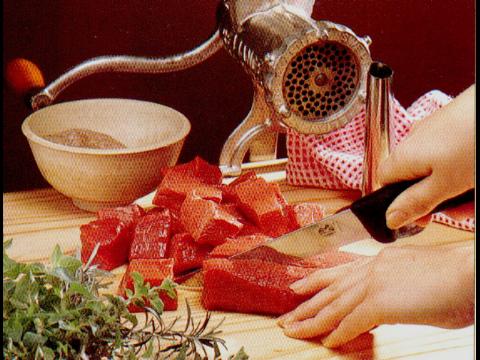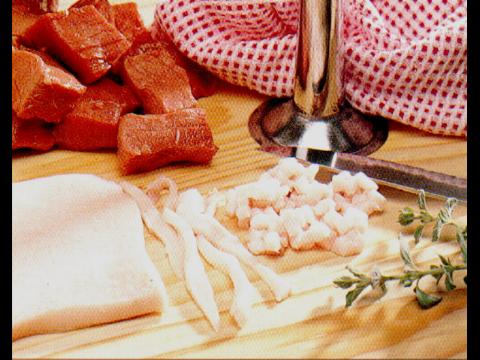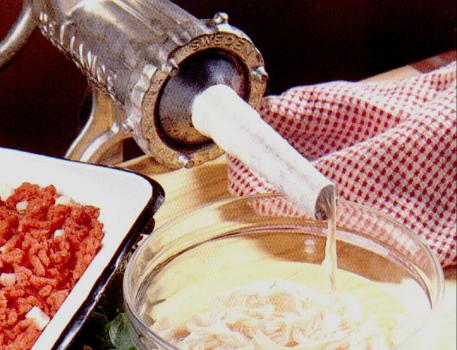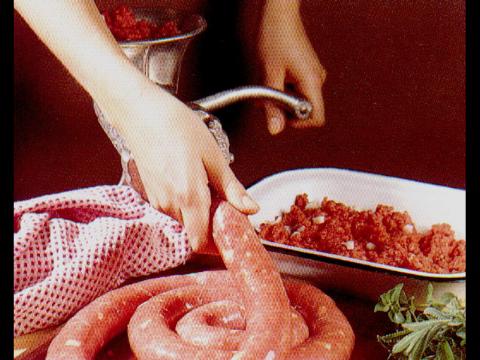There is one thing
we South Africans like, it's our Boerewors!! You can get nothing quite
like it anywhere in the world!
I've decided to tell
here exactly how to make it. Hhmm, Lekker!

Sausage-making is a
very old form of food preservation - it is believed that sausages have
been made for a long as animails have been slaughtered for food. Although
some sausages were eaten fresh, some types were spiced to help prolong
their life for a few days, or dried and preserved for later use.
Today, the making of sausages differs from country
to country and from region to region. This difference may be due to the
type and coarseness of the meat, the proportion of fat to lean meat and
the addition of spices and seasonings. Even the casings used tend to differ
and may be pork, beef, mutton or cellulose.
The making of boerewors
and droewors, sausages peculiar to South Africa, has become
an art-form. This coarse, loose-textured sausage is flavoured with spices
such as coriader, cloves, nutmeg and allspice, but the kind of seasoning
used is often influenced by the area in which the boerewors is made. We
have provided no less than four variations which can serve as the starting
point for the development of your own personal boerewors
recipe.
|
|
Click on the image
to view the larger version
|
|
You've never tasted
anything better!
|
|

|
1. Cut the meat
into 50-mm cubes, sprinkle with combined seasonings
and mix to coat |
| 2. Remove the rind and cut the speck
into long thin strips, then cube or dice |
 |

|
3. Mince the meat, using a 9 mm plate, and add a little of the speck
to each layer of mince |
| 4. Soak the casings in
lukewarm water for about 30 minutes, rince with cold
running water, and pull over sausage filler. |
 |
 |
5. Stuff casing with minced meat - don't overfill
and avoid getting air in. |
THE MEAT
Use fresh, not frozen, beef, pork, mutton or combinations of these meats,
together with speck or sheep's tail fat. Although top grade meat is not
essential, the tough connective tissue must be removed before mincing.
Use meat from young animals as the meat from older animals tends to affect
the colour and binding quality of the sausage. Never wash the meat with
water as this causes spoilage and a tough texture.
Top
BOEREWORS
When making boerewors, use 6 parts meat to 1 part speck. The beef/pork
ratio is a matter of taste, but two parts beef to one part pork will give
an appetizing end result. Cut the meat into 50-mm cubes, spread them on
a clean surface, sprinkle the spices over and mix very lightly.
Dice the speck into 3-mm cubes or if you have a special course mincer plate
it can be minced separately. The object here is to get a mixture of mince
and speck without too much handling. Overhandling results in a polony-like
texture. Boerewors should have a loose, fairly coarse texture. It is important,
therefore, to make sure that the mincer blade and plate are sharp and to
use a mincer plate with large (9 mm) holes. Finer holes will result in
a texutre that is too firm.
Top
SPECK
This is pork fat usually cut in slabs from the belly of a baconer. It
is easier to cut it into slices, squares or dice if it is placed in the
freezer for about 30 minutes before use.
Top
THE SPICES
These should be used with discretion so as not to overpower the
flavour of the meat. Salt and pepper are the main seasonings for almost
all sausages although coriander is the most common spice used for traditional
boerewors. To bring out the flavour, coriander should be scorched, ground
and sieved. (See notes) If whole coriander is not available, use
ground coriander (5 ml ground coriander for every 15 ml whole coriander
required in the recipe.)
other popular additions include ground cloves, nutmeg and crushed garlic.
Herbs such as thyme and marjoram give an interesting flavour but, like
spices, should be used sparingly.
Top
SAUSAGE CASINGS
These are obtainable fromn spice dealers and butchers and can be pork
(available fresh or preserved in salt), beef, mutton or cellulose.
If preserved in salt, casings must be soaked in lukewarm water for about
30 minutes, then rinsed in cold running water before use. Unuased casings
can again be preserved in salt and stored in the refrigerator or freezer.
Pork casings are the best for boerewors while mutton rather than pork
casings should be used for mutton sausages and if you prefer thinner sausages.
When filling the casings, especially at the start of each new casing,
press out all the accumulating air to prevent air bubbles forming. Never
fill the casing too tightly as this will cause it to burst during cooking.
Top
STORING SAUSAGES
Before using or freezing, keep fresh sausages in the refrigerator for
at least a day to dry out the casing and allow the flavours to permeate
the meat thoroughly.
Uncooked boerewors can be stored in the refrigerator for a day or two
while cooked wors can be placed in well-sealed, sterilized bottles and
covered with clean fat. This method of preserving is particularly popular
with campers.
Fresh sausages can be frozen for up to two months after which time
the flavour may change.
Top
COOKING SAUSAGES
It is important to cook your homemade sausages correctly. Place them
in an unheated, riffle pan without the addition of cooking oil or any liquid.
Heat slowly and, without pricking the skin, turn the sausages to brown
on all sides until pan-grilled to taste. The nicest method is of course
the traditional South African "Braaivleis" Boerewors cooked outside over
hot coals, with a glass of South African wine or an ice cold beer. Add
some Pap and a tomato and onion gravy and a green salad.......and you've
got a meal fit for a King! Lekker man, lekkerrrrrrrrrrr!!!!
Top
DROE-WORS (Dried Boerewors)
This is made in mush the same way as boerewors except that pork and
speck are not used (pork fat tends to go rancid). Salpetre may be added
as a preservative but will give the meat a reddish colour.
Dip the filled sausage casings in boiling water to which a good measure
of vinegar has been added (350 ml to 4.5 l of water) Hang
the lenghts of sausage over wooden poles thick enough to keep the inner
surfaces from touching - don't use wire hooks as these could pierce the
casings.
After a day, flatten the partially dried wors to get rid of any air
bubbles where mould may set in. (If the casings are filled loosely they
will flatten more easily.)
To improve the flavour, droewors may be smoked after a day of hanging.
Droewors and smoked droewors can be frozen for up to two months in an airtight
container or wrapped in cling wrap.
Top
 [Index] [History
of Johannesburg 1] [History of Johannesburg 2]
[Do you know Koos Van der Merwe?] [Links][History of Fatti's & Moni's - The pasta kings][How to make Boerewors]
[Index] [History
of Johannesburg 1] [History of Johannesburg 2]
[Do you know Koos Van der Merwe?] [Links][History of Fatti's & Moni's - The pasta kings][How to make Boerewors]
Sign
My Guestbook  View
My Guestbook
Want
your own home page?
View
My Guestbook
Want
your own home page?  Get
one free from Geocities
Get
one free from Geocities


